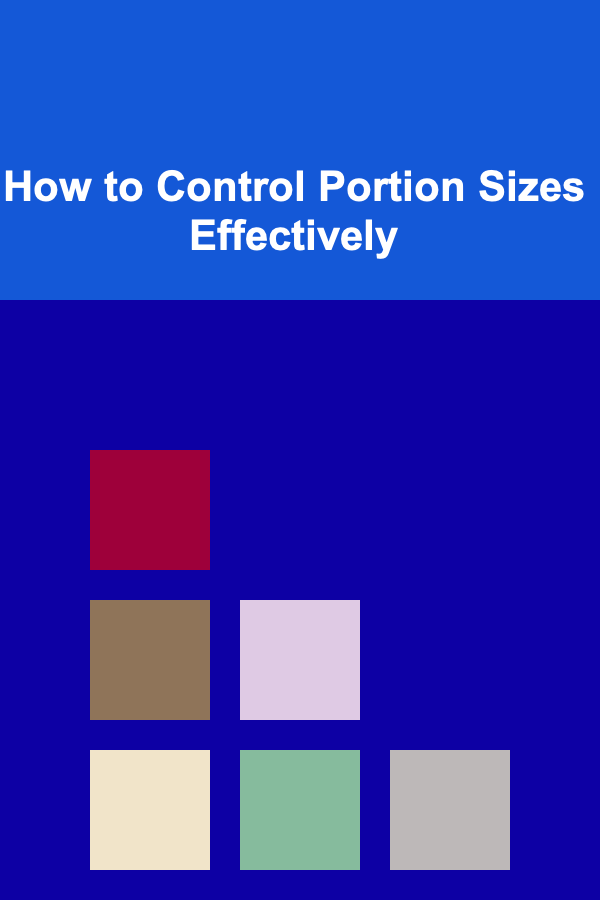
How to Control Portion Sizes Effectively
ebook include PDF & Audio bundle (Micro Guide)
$12.99$7.99
Limited Time Offer! Order within the next:

Portion control is one of the most important aspects of maintaining a healthy diet and achieving long-term health goals. It's a simple concept, yet often one of the most challenging to implement consistently. Overeating, even when the foods are healthy, can lead to weight gain, digestive problems, and other health complications. In a world of supersized servings, it's essential to learn how to control portion sizes effectively to maintain a balanced and healthy lifestyle.
In this article, we will dive into why portion control is crucial, common challenges to portion control, effective strategies for controlling portions, and how to make portion control a sustainable part of your daily routine.
Why is Portion Control Important?
1. Prevents Overeating
One of the biggest challenges in today's food culture is overeating. Portion sizes have significantly increased over the years, particularly in restaurants and fast food chains, leading to the tendency to consume more food than necessary. Controlling portion sizes can help prevent overeating and the subsequent risk of weight gain, high blood pressure, and other related health issues.
2. Supports Weight Management
Portion control is key for weight management, whether you're trying to lose, maintain, or gain weight. Consuming more calories than your body needs can lead to weight gain, while eating fewer than necessary can cause weight loss. By controlling portions, you can ensure that you are eating just enough to fuel your body without overloading it with extra calories.
3. Improves Digestion
Consuming large portions can overwhelm the digestive system, leading to bloating, indigestion, and discomfort. Smaller, more balanced portions give the digestive system a chance to process food properly, ensuring that your body absorbs nutrients efficiently and avoids unnecessary strain.
4. Helps Maintain a Balanced Diet
When you focus on portion control, it naturally encourages a more balanced approach to eating. Rather than eating too much of one food group, portion control forces you to diversify your meals and include a wide range of food types to meet your nutritional needs. This helps you maintain a well-rounded diet, rich in essential vitamins and minerals.
Common Challenges to Portion Control
Despite its importance, controlling portion sizes is not always easy. Several factors can make portion control difficult, including:
1. Super-Sized Portions
In many cultures, especially in the West, portion sizes in restaurants, fast food chains, and even grocery stores have increased dramatically. It's common to find portions that are three or four times larger than what a person actually needs, leading to overeating.
2. Mindless Eating
Many people eat without paying attention to their portions. This can occur during social events, in front of the television, or even when working. Mindless eating leads to consuming more food than necessary, often without realizing it.
3. Emotional Eating
Stress, anxiety, and boredom can all contribute to emotional eating, where people use food to cope with their emotions. During these times, people are more likely to eat larger portions, even if they are not physically hungry, leading to unhealthy eating habits.
4. Lack of Knowledge
Many people don't know what a "normal" portion size looks like, especially when it comes to certain foods. This lack of knowledge can result in people serving themselves large portions without realizing that it exceeds their nutritional needs.
5. Cultural and Social Pressures
In some cultures, food is a major part of social gatherings, and people are often encouraged to eat large portions as a sign of hospitality or enjoyment. This cultural pressure can make portion control more challenging, especially when dining with friends or family.
Effective Strategies for Controlling Portion Sizes
1. Use Smaller Plates and Bowls
One of the easiest ways to control portions is to downsize the plates and bowls you use. Research shows that people tend to eat more when they have larger plates, as they unconsciously fill up the plate. By using smaller dishes, you create a natural limit on how much you can serve yourself, encouraging you to eat less without feeling deprived.
2. Measure and Weigh Your Food
When it comes to controlling portions, it's helpful to measure and weigh your food, especially in the beginning. This allows you to better understand what a proper serving size looks like. You can use measuring cups, spoons, or a food scale to ensure that you're consuming the right amount of each food group.
For example:
- A serving of pasta is about 1 cup (roughly the size of a fist).
- A serving of protein (such as chicken or fish) is typically 3-4 ounces, or about the size of a deck of cards.
- A serving of fruits or vegetables is typically one cup or a palm-sized portion.
3. Practice Mindful Eating
Mindful eating involves paying full attention to the act of eating, savoring each bite, and listening to your body's hunger cues. When you eat mindfully, you're more likely to recognize when you're full, which helps prevent overeating.
To practice mindful eating:
- Eat without distractions (such as the television or phone).
- Focus on the texture, taste, and smell of your food.
- Take smaller bites and chew slowly, allowing your body time to register fullness.
- Check in with yourself during the meal to assess hunger and satiety levels.
4. Pre-Portion Snacks
Snacking can often lead to overeating, especially when snacks are consumed directly from a large bag or container. Instead of eating from a bag, pre-portion your snacks into smaller, single-serving containers. This will help you avoid mindlessly eating larger portions and give you better control over your calorie intake.
5. Fill Up on Vegetables
Vegetables are high in fiber, low in calories, and packed with essential nutrients. By filling up on vegetables first, you can help control your portion sizes for other, higher-calorie foods. Vegetables can be used to bulk up meals, such as salads, soups, or stir-fries, allowing you to eat a larger volume of food while still controlling your overall calorie intake.
6. Eat Protein and Fiber-Rich Foods
Protein and fiber are both satiating nutrients that help keep you feeling full for longer periods of time. By including plenty of protein (such as lean meats, eggs, or plant-based sources like beans and tofu) and fiber (such as whole grains, vegetables, and fruits) in your meals, you can help prevent hunger and reduce the desire to overeat.
7. Avoid Eating Directly from Packages
Eating directly from large containers or packages is a surefire way to lose track of portion sizes. Instead, take a single serving of the food and place it on a plate or in a bowl. This practice encourages you to focus on how much you're eating and helps you avoid mindless snacking.
8. Listen to Your Body's Hunger Cues
Learning to recognize when you're hungry and when you're full is an important skill for portion control. Many people eat out of habit or because food is readily available, not because they're physically hungry. Pay attention to your body's signals and try to eat when you're truly hungry, stopping when you're satisfied but not overly full.
9. Limit the Availability of Tempting Foods
If certain foods are particularly difficult for you to control portions around, consider limiting their availability in your home. This is especially useful for highly processed or snack foods that are easy to overeat. If unhealthy foods are not as accessible, you'll be less likely to mindlessly snack on them.
10. Plan and Prep Meals in Advance
Meal planning and prepping allow you to control portion sizes more easily and avoid overeating. When you prepare meals in advance, you can portion out each meal appropriately, ensuring that you don't eat more than you need. Planning also reduces the likelihood of reaching for unhealthy, large-portion fast food options when hunger strikes.
Overcoming Psychological Barriers to Portion Control
In addition to practical strategies, it's essential to address the psychological factors that can make portion control more difficult.
1. Challenge the "Clean Plate" Mentality
Many people were raised with the belief that they should finish everything on their plate, which can lead to overeating. Challenge this mindset by recognizing that it's okay to leave food behind if you're full. The idea of wasting food can be distressing, but you can always save leftovers for later rather than forcing yourself to eat everything at once.
2. Shift the Focus from Quantity to Quality
Instead of focusing on eating larger portions, shift your focus to the quality of the food. Choose nutrient-dense, whole foods that provide more vitamins, minerals, and fiber, allowing you to feel more satisfied with smaller portions. The more you prioritize healthy, nutrient-rich foods, the less likely you'll feel the need to overeat.
3. Learn to Cope with Social and Emotional Eating
Social situations and emotional stress can trigger overeating. By becoming more aware of the emotional and social triggers that lead to overeating, you can develop healthier coping strategies, such as deep breathing exercises, engaging in physical activity, or having a conversation with a friend, instead of reaching for food.
Conclusion
Portion control is a powerful tool in maintaining a healthy diet and achieving long-term health goals. While it may seem challenging at first, implementing strategies such as using smaller plates, practicing mindful eating, and focusing on nutrient-dense foods can help you control your portions effectively. Additionally, addressing the psychological and social factors that contribute to overeating can help you develop a healthier relationship with food.
Remember, portion control is not about depriving yourself; it's about finding balance. With practice, portion control can become second nature, allowing you to enjoy your meals without the guilt or discomfort of overeating. By making small, sustainable changes to how you approach your meals, you can take control of your health and well-being for years to come.

How to Organize a Family Sports Day in Your Backyard
Read More
How to Sort Recipes by Cooking Time for Quick Meals
Read More
How to Soundproof Your Home Office for Better Productivity
Read More
How to Use Lighting to Enhance Your Home's Appeal
Read More
How To Protect Your Location Data on Smartphones
Read More
10 Tips for Handling Stakeholder Conflicts in Product Management
Read MoreOther Products

How to Organize a Family Sports Day in Your Backyard
Read More
How to Sort Recipes by Cooking Time for Quick Meals
Read More
How to Soundproof Your Home Office for Better Productivity
Read More
How to Use Lighting to Enhance Your Home's Appeal
Read More
How To Protect Your Location Data on Smartphones
Read More